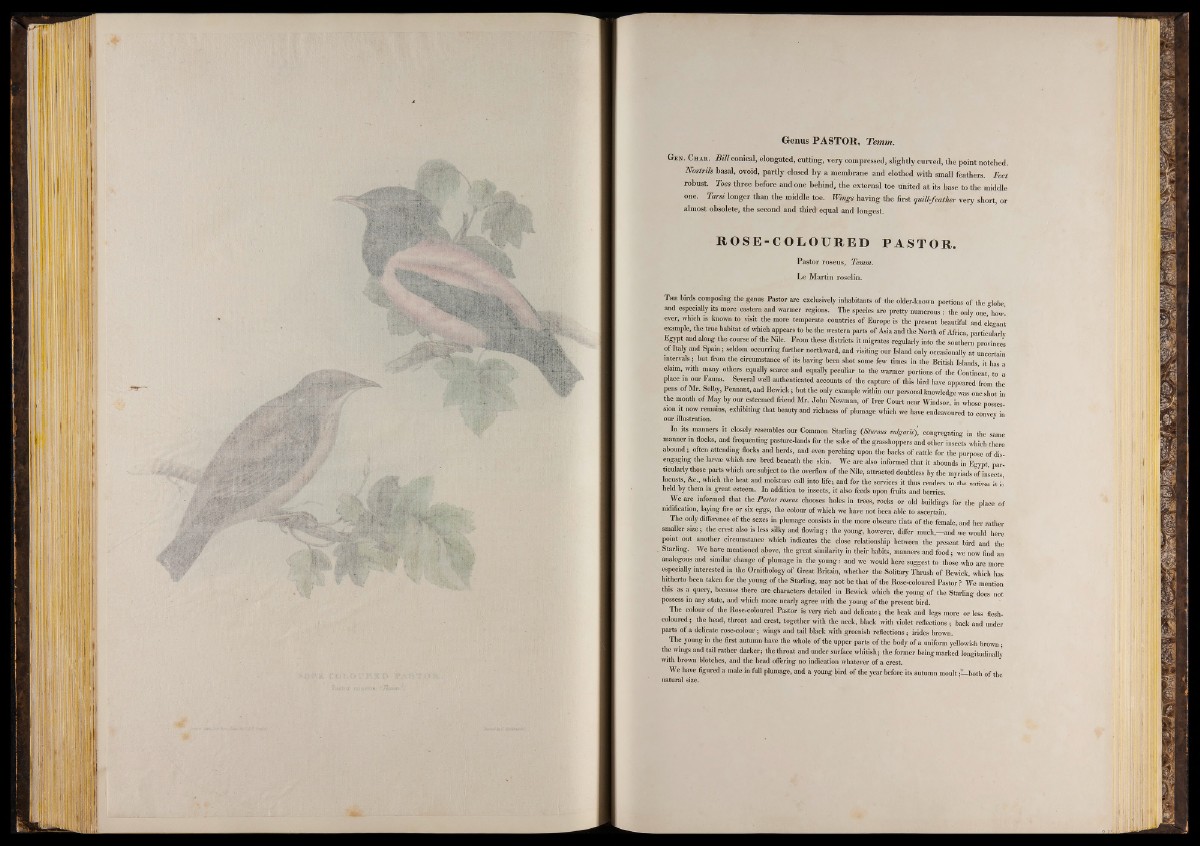
Genus PASTOR, Temm.
G m . Char. B ill conical, elongated, cutting, very compressed, slightly curved, the point notched.
N o strils basal, ovoid, partly closed by a membrane and clothed with small feathers. F eet
robust. Toes three before and one behind, the external toe united at its base to the middle
one. T arsi longer than the middle toe. W ings having the first quill-featlier very short, or
almost obsolete, the second and third equal and longest.
R O S E -C O L O U R E D P A S TO R .
Pastor roseus, Temm.
Le Martin roselin.
The birds composing the genus Pastor are exclusively inhabitants of the older-known portions of the globe
and especially its more eastern and warmer regions. The species are pretty numerous : the only one how’
ever, which is known to visit the more temperate countries o f Europe is the present beautiful and elegant
example, the true habitat of which appears to be the western parts of Asia and the North of Africa, particularly
Egypt and along the course of the Nile. From these districts it migrates regularly into the southern provinces
o f Italy and Spain; seldom occurring further northward, and visiting our Island only occasionally at uncertaia
intervals; but from the circumstance o f its having been shot some few times in the British Islands, it has a
daim, with many others equally scarce and equally peculiar to the warmer portions of the Continent to a
place in our Fauua. Several well authenticated accounts o f the capture o f this bird have appeared from the
pens o f Mr. Selby, Pennant, and Bewick; but the only example within our personal knowledge was one shot in
the month o f May by our esteemed friend Mr. John Newman, o f Iver Court near Windsor, in whose posses
sion it now remains, exhibiting that beauty and richness o f plumage which we have endeavoured to convey in
our illustration.
In its manners it closely resembles our Common Starling (Sturms mlgaris)', congregating in the same
manner in docks, and frequenting pasture-lands for the sake of the grasshoppers and other insects which there
abound; often attending flocks and herds, and even perching upon the backs of cattle for the purpose o f dis
engaging the larvm which are bred beneath the skin. We are also informed that it abounds in Egypt par-
ticularly those parts which are subject to the overflow o f the Nile, attracted doubtless by the myriads of iniects
locusts, &c„ which the heat and moisture call into life; add for the services it thus renders to the natives it is
held by them in great esteem. In addition to insects, it also feeds upon fruits and berries.
_ arc informed that the Pastor roseus chooses holes in trees, rocks or old buildings for the place o f
nidification, laying five or six eggs, the colour o f which we have not been able to ascertain.
The only difference o f the sexes in plumage consists in the more obscure tints of the female, and her rather
smaller size; the crest also is less silky and flowing; the young, however, differ much,—and we would here
point out another circumstance which indicates the close relationship between the present bird and the
Starling. We have mentioned above, the great similarity in their habits, manners and food; we now find an
analogous and similar change of plumage in the young: and we would here suggest to those who are more
especially interested in the Ornithology o f Great Britain, whether the Solitary Thrush of Bewick, which has
hitherto been taken for the young o f the Starling, may not be that of the Rose-coloured Pastor ? We mention
this as a query, because there are characters detailed in Bewick which the young of the Starling does not
possess in any state, and which more nearly agree with the young of the present bird.
The colour of the Rose-coloured Pastor is very rich and delicate; the beak and legs more or less flesh-
coloured; the head, throat and crest, together with the neck, black with violet reflections ; back and under
parts o f a delicate rose-colour; wings and tail black with greenish reflections; irides brown.
The young in the first autumn have the whole of the upper parts of the body o f a uniform yellowish brown;
the wings and tail rather darker; the throat and under surface whitish; the former being marked longitudinally
with brown blotches, and the head offering no indication whatever o f a crest.
We have figured a male in full plumage, and a young bird o f the year before its autumn m o u lt b o t h of the
natural size.